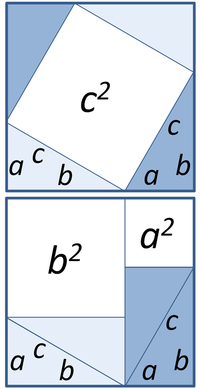
In mathematics and formal logic, a theorem is a statement that has been proven, or can be proven.[a][2][3] The proof of a theorem is a logical argument that uses the inference rules of a deductive system to establish that the theorem is a logical consequence of the axioms and previously proved theorems.
In mainstream mathematics, the axioms and the inference rules are commonly left implicit, and, in this case, they are almost always those of Zermelo–Fraenkel set theory with the axiom of choice (ZFC), or of a less powerful theory, such as Peano arithmetic.[b] Generally, an assertion that is explicitly called a theorem is a proved result that is not an immediate consequence of other known theorems. Moreover, many authors qualify as theorems only the most important results, and use the terms lemma, proposition and corollary for less important theorems.
In mathematical logic, the concepts of theorems and proofs have been formalized in order to allow mathematical reasoning about them. In this context, statements become well-formed formulas of some formal language. A theory consists of some basis statements called axioms, and some deducing rules (sometimes included in the axioms). The theorems of the theory are the statements that can be derived from the axioms by using the deducing rules.[c] This formalization led to proof theory, which allows proving general theorems about theorems and proofs. In particular, Gödel's incompleteness theorems show that every consistent theory containing the natural numbers has true statements on natural numbers that are not theorems of the theory (that is they cannot be proved inside the theory).
As the axioms are often abstractions of properties of the physical world, theorems may be considered as expressing some truth, but in contrast to the notion of a scientific law, which is experimental, the justification of the truth of a theorem is purely deductive.[6][7] A conjecture is a tentative proposition that may evolve to become a theorem if proven true.
- ^ Elisha Scott Loomis. "The Pythagorean proposition: its demonstrations analyzed and classified, and bibliography of sources for data of the four kinds of proofs" (PDF). Education Resources Information Center. Institute of Education Sciences (IES) of the U.S. Department of Education. Retrieved 2010-09-26. Originally published in 1940 and reprinted in 1968 by National Council of Teachers of Mathematics.
- ^ "Definition of THEOREM". Merriam-Webster. Retrieved 2019-11-02.
- ^ "Theorem | Definition of Theorem by Lexico". Lexico Dictionaries | English. Archived from the original on November 2, 2019. Retrieved 2019-11-02.
- ^ McLarty, Colin (2010). "What does it take to prove Fermat's last theorem? Grothendieck and the logic of number theory". The Review of Symbolic Logic. 13 (3). Cambridge University Press: 359–377. doi:10.2178/bsl/1286284558. S2CID 13475845.
- ^ McLarty, Colin (2020). "The large structures of Grothendieck founded on finite order arithmetic". Bulletin of Symbolic Logic. 16 (2). Cambridge University Press: 296–325. arXiv:1102.1773. doi:10.1017/S1755020319000340. S2CID 118395028.
- ^ Markie, Peter (2017), "Rationalism vs. Empiricism", in Zalta, Edward N. (ed.), The Stanford Encyclopedia of Philosophy (Fall 2017 ed.), Metaphysics Research Lab, Stanford University, retrieved 2019-11-02
- ^ However, both theorems and scientific law are the result of investigations. See Heath 1897 Introduction, The terminology of Archimedes, p. clxxxii:"theorem (θεὼρνμα) from θεωρεἳν to investigate"
Cite error: There are <ref group=lower-alpha> tags or {{efn}} templates on this page, but the references will not show without a {{reflist|group=lower-alpha}} template or {{notelist}} template (see the help page).